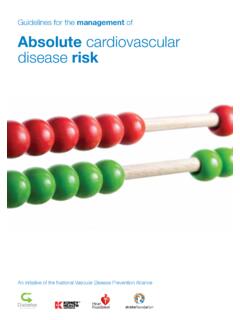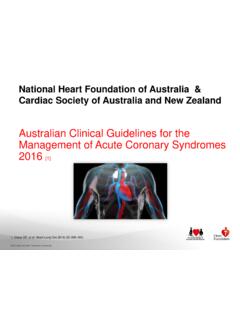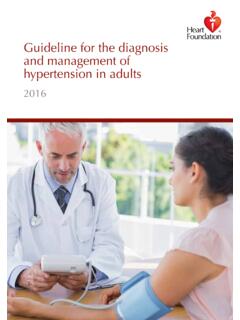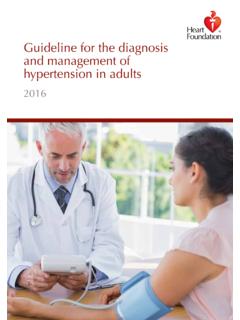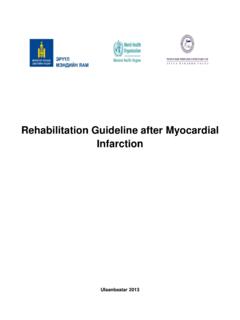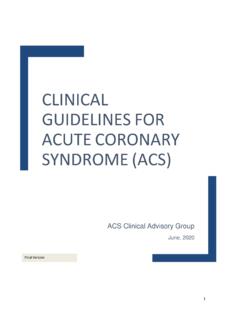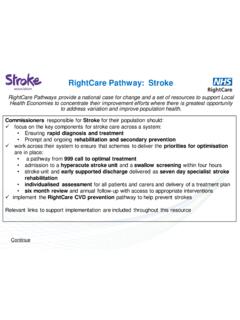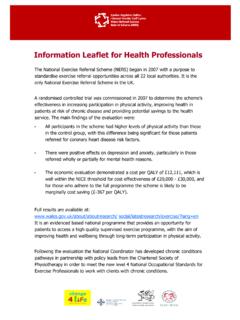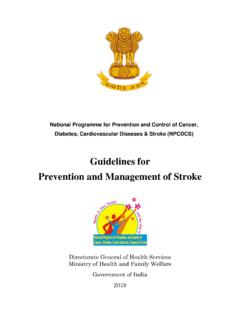Transcription of 895–951 POSITION STATEMENT 1443-9506/04/$36.00 …
1 National Heart Foundation of Australia & cardiac Society of Australia andNew Zealand: Australian ClinicalGuidelines for the Management of AcuteCoronary Syndromes 2016 ContentsExecutive Summary .. 897 Key Evidence-Based Recommendations .. 8981 Preamble .. Incidence .. Contemporary Outcomes of ACS and Chest Pain in Australia .. The Process of Developing the 2016 ACS Guidelines .. Conflicts of Interest Process .. Development of Recommendations .. 9032 Assessment of Possible cardiac Chest Pain .. Initial Evaluation .. Outpatient Presentation .. Emergency Department Presentation .. Initial ECG and Assessment .. Differential Diagnosis .. Initial Clinical Management .. Risk Scores and Clinical Assessment Protocols .. Biomarkers .. Further Diagnostic Testing .. Representation with Symptoms.. Discharge Advice .. 9163 Diagnostic Considerations and Risk Stratification of Acute Coronary Syndromes .. Diagnostic Considerations.. Risk Stratification for Patients with Confirmed ACS.
2 9174 Acute Reperfusion and Invasive Management Strategies in Acute Coronary Syndromes.. Reperfusion for STEMI .. Ongoing Management of Fibrinolytic-Treated Patients .. Early Invasive Management for NSTEACS .. 9215 Pharmacotherapy of Acute Coronary Syndromes .. Acute Anti-Ischaemic Therapies .. Antiplatelet Therapy .. Anticoagulant Therapy .. Duration of cardiac Monitoring .. 931 2016 National Heart Foundation of Australia. Published by Elsevier behalf of Australian and New Zealand Society of cardiac and Thoracic Surgeons (ANZSCTS) and theCardiac Society of Australia and New Zealand (CSANZ). This is an open access article under the CC BY-NC-ND license ( ).Heart, Lung and Circulation (2016) 25, 895 9511443-9506/04/$ STATEMENT6 Discharge Management and secondary prevention .. Late and Post-Hospital Pharmacotherapy .. secondary prevention .. 9357 System Considerations, Measures of Performance and Clinical Standards .. 9368 Areas for Further Research.
3 9379 ACS Therapies Currently not Approved in Australia .. 938 Appendix 1: Consultation and Endorsing Organisations .. 946 Appendix 2: Online Register of Conflicts of Interest .. 946 Appendix 3: Clinical Questions for NHFA/CSANZ ACS Guideline Update Literature Review .. 947 Appendix 4: NHMRC Guideline Development Methodology .. 948 Appendix 5: GRADE Methodology for Recommendations .. 950896 Chew et ACS Guideline 2016 Executive Working Group:Derek P. Chew, MBBS MPH FRACPa, Ian A. Scott, MBBS FRACP MHAf,Louise Cullen, MBBS FACEM PhDc, John K. French, BMedSC MBChb PhDe,Tom G. Briffa, PhDh, Philip A. Tideman, MBBS FRACP FCSANZb,Stephen Woodruffe, BAppSci (HMS)g, Alistair Kerri, Maree Branagan, MPHj,Philip Aylward, BM BCh PhD FRACPdaFlinders University and Regional Director of Cardiology, Department of Cardiovascular Medicine, Southern Adelaide Health Service, SA, AustraliabIntegrated Cardiovascular Clinical Network (iCCnet), Country Health SA Local Health Network and Southern Adelaide Local Health Network, Adelaide,SA, AustraliacDepartment of Emergency Medicine, Royal Brisbane and Women s Hospital, Brisbane, Qld, AustraliadNetwork Director, Division of Medicine, cardiac and Critical Care, Southern Adelaide Local health Network, Flinders Medical Centre and University,SAHMRI, Adelaide, SA, AustraliaeDirector of Coronary Care and Director of Cardiovascular Research, Liverpool Hospital, Sydney, NSW, AustraliafInternal Medicine and Clinical Epidemiology, Princess Alexandra Hospital, Brisbane, Qld, Australia.
4 School of Medicine, University of Queensland,Brisbane, Qld, Australia; Medicine, Monash University, Melbourne, Vic, AustraliagIpswich cardiac rehabilitation and Heart Failure Service, Ipswich, Qld, AustraliahCardiovascular Research Group, School of Population Health, University of Western Australia, Perth, WA, AustraliaiGuidelines Consumer representative, Melbourne, Vic, AustraliajSenior Policy Advisor, National Heart Foundation of AustraliaExecutive SummaryThese clinical guidelines have been developed to assist in themanagement of patients presenting with chest pain sus-pected to be due to an acute coronary syndrome (ACS)and those with confirmed ACS. These guidelines shouldbe read in conjunction with the ACS Clinical Care Standardsdeveloped by the Australian Commission for Safety andQuality in Health Care (ACSQHC) [1] and the Australianacute coronary syndromes capability framework developed bythe Heart Foundation [2]. Additional guidance around thetiming and use of therapies is detailed in the accompanyingpractice Heart Foundation of Australia & cardiac Society of Australia and New Zealand 897 Key Evidence-Based RecommendationsRecommendation GRADE strength ofrecommendationNHMRC Level ofEvidence (LOE)Initial assessment of chest painIt is recommended that a patient with acute chest pain orother symptoms suggestive of an ACS receives a 12-lead ECGand this ECG is assessed for signs of myocardial ischaemia byan ECG-experienced clinician within 10 minutes of first acuteclinical IIICA patient presenting with acute chest pain or othersymptoms suggestive of an ACS should receive care guidedby an evidence-based Suspected ACS Assessment Protocol(Suspected ACS-AP)
5 That includes formal risk IAUsing serial sampling, cardiac -specific troponin levelsshould be measured at hospital presentation and at clearlydefined periods after presentation using a validated SuspectedACS-AP in patients with symptoms of possible IANon-invasive objective testing is recommended inintermediate-risk patients, as defined by a validated SuspectedACS-AP, with normal serial troponin and ECG testing andwho remain IAPatients in whom no further objective testing for coronaryartery disease (CAD) is recommended are those at low risk, asdefined by a validated Suspected ACS-AP: age <40 years,symptoms atypical for angina, in the absence of known CAD,with normal troponin and ECG testing, and who III-3 CDiagnostic considerations and risk stratification of ACSThe routine use of validated risk stratification tools forischaemic and bleeding events ( GRACE score forischaemic risk or CRUSADE score for bleeding risk) mayassist in patient-centric clinical decision-making in regards toACS IIIBA cute reperfusion and invasive management strategies in ACSFor patients with ST elevation myocardial infarction(STEMI) presenting within 12 hours of symptom onset, and inthe absence of advanced age, frailty and comorbidities thatinfluence the individual s overall survival, emergencyreperfusion therapy with either primary percutaneouscoronary intervention (PCI) or fibrinolytic therapy IAPrimary PCI is preferred for reperfusion therapy inpatients with STEMI if it can be performed within 90 minutesof first medical contact.
6 Otherwise fibrinolytic therapy ispreferred for those without IAAmong patients treated with fibrinolytic therapy who arenot in a PCI-capable hospital, early or immediate transfer to aPCI-capable hospital for angiography, and PCI if indicated,within 24 hours is IIA898 Chew et al.(Continued).Recommendation GRADE strength ofrecommendationNHMRC Level ofEvidence (LOE)Among patients treated with fibrinolytic therapy, for thosewith 50% ST recovery at 60 90 minutes, and/or withhaemodynamic instability, immediate transfer for angiographywith a view to rescue angioplasty is IBAmong high- and very high-risk patients with non-STelevation acute coronary syndromes (NSTEACS) (except Type2 MI), a strategy of angiography with coronaryrevascularisation (PCI or coronary artery bypass grafts) whereappropriate is IAPatients with NSTEACS who have no recurrent symptomsand no risk criteria are considered at low risk of ischaemicevents, and can be managed with a selective invasive strategyguided by provocative testing for inducible IATiming of invasive management for NSTEACSVery high-risk patients.
7 Among patients with NSTEACS with very high-risk criteria (ongoing ischaemia,haemodynamic compromise, arrhythmias, mechanicalcomplications of MI, acute heart failure, recurrent dynamic orwidespread ST-segment and/or T-wave changes on ECG), animmediate invasive strategy is recommended ( within 2hours of admission).Strong IICHigh-risk patients: In the absence of very high-risk criteria,for patients with NSTEACS with high-risk criteria (GRACE score >140, dynamic ST-segment and/orT-wave changes on ECG, or rise and/or fall in troponincompatible with MI) an early invasive strategy isrecommended ( within 24 hours of admission).Weak ICIntermediate risk patients: In the absence of high-riskcriteria, for patients with NSTEACS with intermediate-riskcriteria (such as recurrent symptoms or substantial inducibleischaemia on provocative testing), an invasive strategy isrecommended ( within 72 hours of admission).Weak IICP harmacology for ACSA spirin 300 mg orally initially (dissolved or chewed)followed by 100 150 mg/day is recommended for all patientswith ACS in the absence of IAAmong patients with confirmed ACS at intermediate tovery high- risk of recurrent ischaemic events, use of a P2Y12inhibitor (ticagrelor 180 mg orally, then 90 mg twice a day or;prasugrel 60 mg orally, then 10 mg daily; or clopidogrel300 600 mg orally, then 75mg per day) is recommended inaddition to aspirin.
8 (Ticagrelor or prasugrel preferred: seepractice advice)Strong IAIntravenous glycoprotein IIb/IIIa inhibition in combinationwith heparin is recommended at the time of PCI amongpatients with high-risk clinical and angiographiccharacteristics, or for treating thrombotic complicationsamong patients with IBNational Heart Foundation of Australia & cardiac Society of Australia and New Zealand 899(Continued).Recommendation GRADE strength ofrecommendationNHMRC Level ofEvidence (LOE)Either unfractionated heparin or enoxaparin isrecommended in patients with ACS at intermediate to highrisk of ischaemic IABivalirudin ( mg/kg IV with mg/kg/hr infusion)may be considered as an alternative to glycoprotein IIb/IIIainhibition and heparin among patients with ACS undergoingPCI with clinical features associated with an increased risk ofbleeding IIBD ischarge management and secondary preventionAspirin (100 150 mg/day) should be continued indefinitelyunless it is not tolerated or an indication for anticoagulationbecomes IAClopidogrel should be prescribed if aspirin iscontraindicated or not IADual-antiplatelet therapy with aspirin and a P2Y12inhibitor (clopidogrel or ticagrelor) should be prescribed forup to 12 months in patients with ACS, regardless of whethercoronary revascularisation was performed.
9 The use ofprasugrel for up to 12 months should be confined to patientsreceiving IAConsider continuation of dual-antiplatelet therapy beyond12 months if ischaemic risks outweigh the bleeding risk ofP2Y12inhibitor therapy; conversely consider discontinuation ifbleeding risk outweighs ischaemic IICI nitiate and continue indefinitely, the highest tolerateddose of HMG-CoA reductase inhibitors (statins) for a patientfollowing hospitalisation with ACS unless contraindicated orthere is a history of IAInitiate treatment with vasodilatory beta blockers inpatients with reduced left ventricular (LV) systolic function(LV ejection fraction [EF] 40%) unless IIAI nitiate and continue angiotensin converting enzyme (ACE)inhibitors (or angiotensin receptor blockers [ARBs]) in patientswith evidence of heart failure, LV systolic dysfunction,diabetes, anterior myocardial infarction or IAAttendance at cardiac rehabilitation or undertaking astructured secondary prevention service is recommended forall patients hospitalised with IANote.
10 Refer to Appendix 4 for details on the National Health and Medical Research Council (NHMRC) guideline development methodology, including grades ofevidence, and Appendix 5 for details on the GRADE Chew et IncidenceAcute coronary syndromes (ACS) myocardial infarction(MI) and unstable angina (UA) are the result of unstableatheromatous plaques or endothelial disruption with asso-ciated transient or permanent thrombotic occlusion of thecoronary vascular tree leading to myocardial ischaemiaand infarction. As a result of the improved sensitivity oftroponin assays, incidence of unstable angina is decreasingwith a proportionate increase in the incidence of MI. In2012, the Australian Institute of Health and Welfare esti-mated there were 68,200 ACS events [3]. Chest pain andother symptoms suggestive of possible ACS are commonpresenting complaints in the emergency department (ED)[4]. It is estimated that over 500,000 patients present inAustralia each year with chest pain, but more than 80% ofall patients investigated for ACS will not have this diag-nosis confirmed [5].
